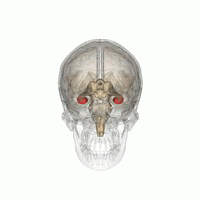
Photo from wikipedia
Activation of transient receptor potential vanilloid 4 (TRPV4) can increase hippocampal neuronal excitability. TRPV4 has been reported to be involved in the pathogenesis of epilepsy. Voltage‐gated potassium channels (VGPCs) play… Click to show full abstract
Activation of transient receptor potential vanilloid 4 (TRPV4) can increase hippocampal neuronal excitability. TRPV4 has been reported to be involved in the pathogenesis of epilepsy. Voltage‐gated potassium channels (VGPCs) play an important role in regulating neuronal excitability and abnormal VGPCs expression or function is related to epilepsy. Here, we examined the effect of TRPV4 activation on the delayed rectifier potassium current (IK) in hippocampal pyramidal neurons and on the Kv subunits expression in male mice. We also explored the role of TRPV4 in changes in Kv subunits expression in male mice following pilocarpine‐induced status epilepticus (PISE). Application of TRPV4 agonists, GSK1016790A and 5,6‐EET, markedly reduced IK in hippocampal pyramidal neurons and shifted the voltage‐dependent inactivation curve to the hyperpolarizing direction. GSK1016790A‐ and 5,6‐EET‐induced inhibition of IK was blocked by TRPV4 specific antagonists, HC‐067047 and RN1734. GSK1016790A‐induced inhibition of IK was markedly attenuated by calcium/calmodulin‐dependent kinase II (CaMKII) antagonist. Application of GSK1016790A for up to 1 hr did not change the hippocampal protein levels of Kv1.1, Kv1.2, or Kv2.1. Intracerebroventricular injection of GSK1016790A for 3 d reduced the hippocampal protein levels of Kv1.2 and Kv2.1, leaving that of Kv1.1 unchanged. Kv1.2 and Kv2.1 protein levels as well as IK reduced markedly in hippocampi on day 3 post PISE, which was significantly reversed by HC‐067047. We conclude that activation of TRPV4 inhibits IK in hippocampal pyramidal neurons, possibly by activating CaMKII. TRPV4‐induced decrease in Kv1.2 and Kv2.1 expression and IK may be involved in the pathological changes following PISE.
Journal Title: Journal of Neuroscience Research
Year Published: 2020
Link to full text (if available)
Share on Social Media: Sign Up to like & get
recommendations!